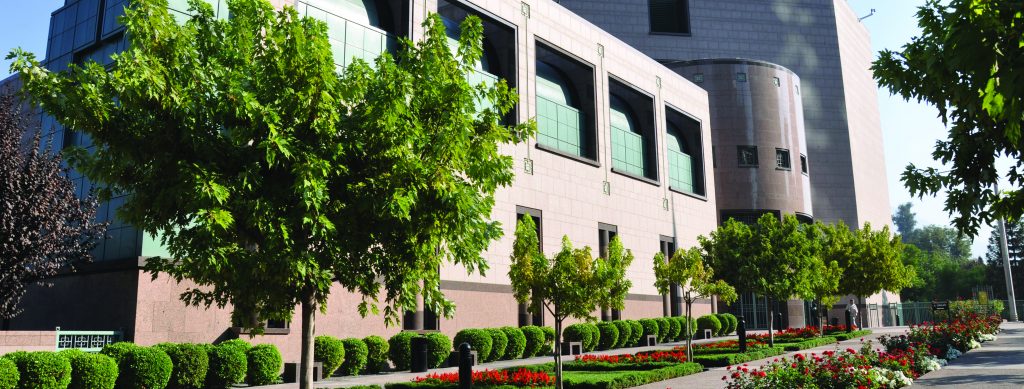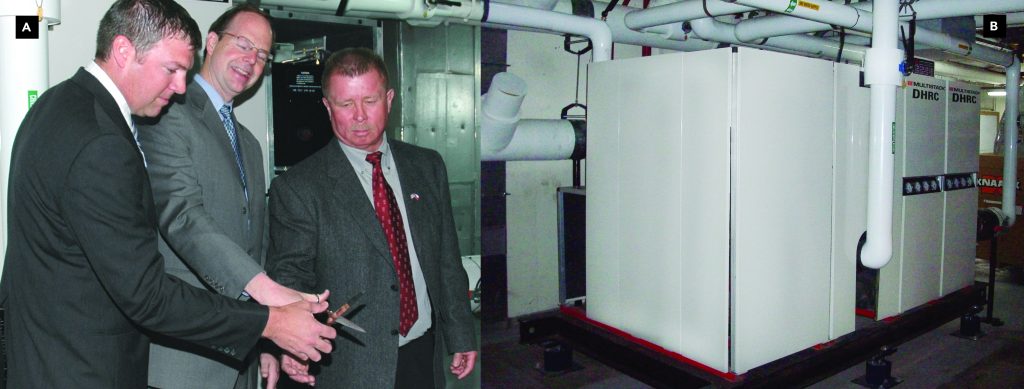Santiago Embassy: Saving energy and reducing impact on the environment with a Multistack Dedicated Heat Recovery Chiller System
Santiago, Chile
Saving energy and reducing impact on the environment with a Multistack dedicated heat recovery chiller system

U.S. State Department Overseas Building Operations (OBO) had been tasked with the replacement of 12-year-old cooling towers at the U.S. Embassy in Santiago, Chile. Doing so, by installing a new sustainable water chiller has led to both energy and cost savings and reduction of environmental impact. OBO knew that Multistack’s Dedicated Heat Recovery Chiller (DHRCTM) system would prove to be the best answer to the embassy’s cooling and heating needs, with an anticipated payback of just three and a half years.
The timing of the cooling tower replacement was fortuitous. U.S. State Department Overseas Building Operations’ Mechanical Engineer, Richard Sullivan, was working with the Santiago post, and had recently attended a seminar on DHRC systems. Multistack’s DHRC offers reduced carbon dioxide emissions, economical water heating, built-in redundancy for critical applications, and flexible installation because of its modular design; the DHRC accomplishes this by providing simultaneous chilled water for a facility’s cooling system while also providing hot water for its heating system. Sullivan thought that the DHRC system would be a perfect fit for the Santiago Embassy’s needs. “Chile has a mild climate; it’s fairly cold in the winter, but not too hot in summer, and there are a lot of instances when the Embassy was running its diesel fuel boilers and chillers at the same time because of the electrical loads in the building,” explains Sullivan. “These electrical loads generate a lot of discharged heat, even in winter.” Motivated by reduction of maintenance costs and water use, Sullivan’s team found the DHRC would also support the Energy Policy Act enacted by the Federal government which mandates the State Department to look at opportunities for energy savings. Like most federal agencies, OBO had an energy budget and money allocated for energy efficient improvement projects.
“OBO has a policy of energy payback in seven years,” said Sullivan. “We figured the DHRC would have a three to five year payback, and were pleased to see return on our investment much sooner, even with the additional costs associated with security requirements to use American contractors in international embassies.”
The cost savings to the Embassy in Santiago were easy to calculate. Officials simply looked at the energy consumption of the old boiler system as a guideline. Since the boilers have only been used once since the installation of the DHRC (due to a facility power outage), and since the DHRC requires no more energy to operate than the facility’s primary chilled water system, the energy savings of the new system are to the past costs of operating the existing diesel boiler. That cost, at the time the DHRC was installed, calculated at $94,000 per year. At that rate, the system would have paid for itself in less than three years. A drop in the cost of fuel oil increased the initial payback calculation to just over three and a half years – still exceptional. Even with these relatively low fuel costs, the life-cycle energy savings tothe Embassy is $1,280,000!
Further, it was easy to see that more was saved than just money. Again, since the DHRC created no incremental increase in electrical energy consumption, the reduction in CO2 emissions was just as easy to calculate. By looking at the previous emissions associated with the diesel boiler, the data shows that the DHRC has reduced the CO2 emissions of the US Embassy in Santiago by nearly 170 metric tons per year – a major accomplishment for a system that should pay for itself during its first three and a half years of operation. The DHRC handles heating for the whole building, in addition to providing heating for the embassy’s domestic water system – all while providing chilled water to supplement the facility’s cooling needs.
The DHRC system operates on a simple concept. When excess heat is generated (i.e. from computer rooms, internal building zones, etc.), the DHRC grabs the heat, transports and converts it to usable hot water at temperatures up to 160°F. The system simultaneously cools a hot area in a building while providing heat in the form of hot water to other areas of the facility as needed. Multistack’s DHRC system and Ultra-High Efficiency Airstack Air-Cooled Chillers in Santiago offer numerous additional advantages. The new air cooled chillers reduce maintenance as compared to the previous water cooled chillers. Also, by eliminating the need for a cooling tower, water consumption by the air conditioning system was reduced to zero.
“The new sustainable system has reduced the Embassy’s water consumption by approximately 2 million gallons a year,” said Vern Martinez, President of Martinez International, the contractor who installed the DHRC. “And we are saving thousands of dollars with Multistack’s air-cooled chillers because they no longer need the costly chemical treatments required under the old system.”
From a maintenance perspective, the DHRC system also makes sense at global locations. “The modular concept uses smaller non-proprietary components that have worldwide availability and are more easily maintained by global staff,” said Therman Campbell, the embassy’s
FAST FACTS:
Actual Performance through 30-Months of Operation:
- $$$ Savings = $170,000
- Fuel Oil Savings = 42,500 US Gallons
- Emissions Reduction = 420 Metric Tons of CO2
Expected Life-Cycle Savings Based on Initial 30-Month Performance (Current $’S)
- $$$ Savings = $1,280,000
- Fuel Oil Savings = 320,000 US Gallons
- Emissions Reductions = 3,200 Metric Tons of CO2

A: Ribbon Cutting. B: Inside the equipment room of the Embassy, sits the Multistack DHRC
Facility Manager. Conventional chillers with larger single compressors are more difficult to maintain and parts much more difficult to source; local staff are more likely to have seen the 20 or 30 ton compressors used in the Multistack Modular Chillers. The chillers’ smaller size also facilitates simple installation because they easily fit through doorways 22 inches or wider. Instead of a chiller weighing thousands of pounds, the system is divided into modules that can be assembled into a chiller of the required capacity. It also offers flexibility for future growth.
The Santiago embassy’s installation of the DHRC system represents a first in this type of progressive, sustainable technology in South America. Multistack’s Dedicated Heat Recover Chiller system at the Santiago embassy has now become a standard in embassy design for any place that’s cold enough to have a significant winter time heating requirement. Installations of similar systems, with similar performance, are now in US Embassies in: Lisbon, Portugal; Sophia, Bulgaria; and Kiev, Ukraine



